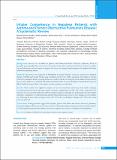Please use this identifier to cite or link to this item:
https://hdl.handle.net/20.500.14356/879Full metadata record
| DC Field | Value | Language |
|---|---|---|
| dc.contributor.author | Poudel, Ramesh Sharma | - |
| dc.contributor.author | Shrestha, Shakti | - |
| dc.contributor.author | Erku, Daniel Asfaw | - |
| dc.contributor.author | Lamichhane, Praves | - |
| dc.contributor.author | Karki, Sharad | - |
| dc.contributor.author | Maskey, Dipesh | - |
| dc.contributor.author | Adhikari, Shital | - |
| dc.date.accessioned | 2023-04-03T06:33:27Z | - |
| dc.date.available | 2023-04-03T06:33:27Z | - |
| dc.date.issued | 2022 | - |
| dc.identifier.citation | PokhrelS., ShresthaD., ShresthaR. K., BudhathokiS., SahA. K., ParajuliP., RayaG. B., MorimotoK., & DhoubhadelB. G. (2022). Characteristics of Pregnant Women and Risk Factors of Their Newborn for Admission to a Neonatal Intensive Care Unit in Nepal. Journal of Nepal Health Research Council, 20(02), 289-295. | en_US |
| dc.identifier.issn | Print ISSN: 1727-5482; Online ISSN: 1999-6217 | - |
| dc.identifier.uri | http://103.69.126.140:8080/handle/20.500.14356/879 | - |
| dc.description.abstract | Abstract Background: Incorrect use of inhalers in patients with asthma and chronic obstructive pulmonary disease is prevalent internationally. This review aims to determine the prevalence and associated factors of incorrect inhaler use and effectiveness of intervention to improve the correct use among Nepalese patients with asthma and chronic obstructive pulmonary disease. Methods: The protocol was registered in PROSPERO. Systematic literature search was performed in PubMed, Embase, CINAHL,and Google Scholar using predefined search terms. Studies in patients with asthma or chronic obstructive pulmonary disease, reporting at least one overall or critical error, using dry powder inhalers and pressurized metered dose inhalers were included. The quality of included studies was assessed using the National Heart, Lung, and Blood Quality Assessment Tools. A descriptive narrative synthesis was undertaken. Results: Twelve studies were eligible for analysis. At least one overall and critical step of the inhaler technique was performed incorrectly by the large number of patients, ranging from 64-100% and 9-100%, respectively. The incorrect use was associated with factors related to patients, inhalers, and health care professionals. The interventions included a combination of verbal instruction, physical demonstration, and/or face-to-face training on correct inhaler use. Following the intervention, an improvement of 23-37% in the overall inhaler technique and 7-42% in the critical steps was achieved. Conclusions: Existing literature suggests that Nepalese patients with asthma and chronic obstructive pulmonary disease have high overall and critical error rates in the use of dry powder inhalers and pressurized metered dose inhalers. A well-designed educational intervention is necessary to improve the correct use of inhalers in this population. Keywords: Asthma; COPD; Dry powder inhalers; Metered-dose inhalers; Nepal | en_US |
| dc.language.iso | en | en_US |
| dc.publisher | Nepal Health Research Council | en_US |
| dc.relation.ispartofseries | Vol. 20 No. 02 (2022): Issue 55 April-June, 2022; | - |
| dc.subject | Asthma | en_US |
| dc.subject | COPD | en_US |
| dc.subject | Metered-dose inhalers | en_US |
| dc.subject | Nepal | en_US |
| dc.title | Inhaler Competence in Nepalese Patients with Asthma and Chronic Obstructive Pulmunory Disease: A Systematic Review | en_US |
| dc.type | Journal Article | en_US |
| Appears in Collections: | Vol 20 No 02 Issue 55 April-June, 2022 | |
Files in This Item:
| File | Description | Size | Format | |
|---|---|---|---|---|
| 4113-Manuscript-29668-2-10-20221103.pdf | Full Article. | 418.43 kB | Adobe PDF |  View/Open |
Items in DSpace are protected by copyright, with all rights reserved, unless otherwise indicated.
